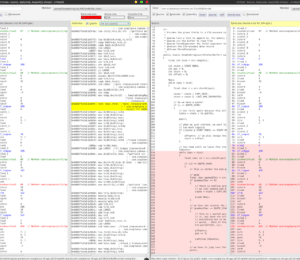Concurrency in Java (and How it Compares with Other Modern Programming Languages)
- June 15, 2021
- 3233 Unique Views
- 8 min read

This is a multi-part series where I talk about concurrency in modern programming languages and build and benchmark a concurrent web server, inspired by the example from the Rust book, in popular languages like Java, Rust, Go, JavaScript (NodeJS), TypeScript (Deno) and Kotlin to compare concurrency and its performance between these languages/platforms.
The chapters of this series are as below, with part 6 here on Foojay.io, the place for friends of OpenJDK.
- Introduction
- Concurrent web server in Rust
- Concurrent web server in Golang
- Concurrent web server in JavaScript with NodeJS
- Concurrent web server in TypeScript with Deno
- Concurrent web server in Java with JVM
- Concurrent web server in Kotlin with JVM
- Comparison and conclusion of benchmarks
Concurrency in Java
"The Java programming language and the Java virtual machine (JVM) have been designed to support concurrent programming, and all execution takes place in the context of threads. " -- Wikipedia
Java has had support for concurrent programming from its early days. Prior to Java 1.1 it even had support for green threads (virtual threads). Spoiler Alert! It's coming back again with Project Loom.
Concurrent programming has always been at the core of Java as it was aimed at multi-threaded and multi-core CPUs. While not as simple as goroutines to use, it was powerful and flexible for almost any use case. While powerful, it's also quite complex especially when you have to access data between threads since the default mechanism in Java, due to its OOP roots, is to use shared state concurrency by synchronizing the threads.
Threads are at the core of concurrent & asynchronous programming in Java. From JDK 1.1 onwards these threads would map 1:1 to OS threads. Due to its early inception, the ecosystem has really mature libraries as well, from HTTP servers to concurrent message processors and so on. Asynchronous programming caught up a bit late in Java, the building blocks were there but it was practically useable only from Java 8, but it has matured as well and now has a great ecosystem with support for reactive programming and asynchronous concurrency.
Java 8 bought a lot of improvements and simplifications to make it easier to do concurrency. For example, standard Java APIs like the Stream API even provides a way to do parallel processing easily by just invoking a method call on complex and CPU intensive pipelines.
With Java, it's possible to do multi-threaded concurrency or parallel programming as well as asynchronous programming. This means as we saw in the first chapter, we can mix and match these models to get the best possible performance for any use case.
Multi-threading
Java provides building blocks to create and manage OS threads as part of the standard library and it also provides implementations required for shared-state concurrency using locks and synchronization. Message-passing concurrency is not provided by default but can be done using external libraries like Akka or using an Actor model implementation. However, due to the memory model, it's up to the developer to ensure there are no data races or memory leaks in the concurrent program.
In order to make multi-threading even more efficient, Java provides ways to create thread pools and reuse those threads to increase throughput. This will become even better once Project loom is released, hopefully with Java 17 or 18. Technically Java has one of the most mature ecosystems when it comes to multi-threading and most Java frameworks that you would end up using will be making use of it internally for performance improvements.
Asynchronous processing
Technically asynchronous programming is not part of concurrency but in practice, it goes hand in hand for many use cases and improves performance, and makes resource usage more efficient. In Java asynchronous programming is achieved using the same building blocks as concurrent/parallel programming. a.k.a, Threads. This wasn't very popular in Java before Java 8 due to complexity and, let's be honest, the lack of things like lambdas, functional programming support, CompletableFuture, and so on.
The latest versions of Java provide the building blocks required for asynchronous programming with standard interfaces and implementations. But do keep in mind that using an asynchronous programming model increases the overall complexity and the ecosystem is still evolving. There are also many popular libraries and frameworks like Spring and RxJava that support asynchronous/reactive programming.
Java still doesn't have any syntax sugar for async/await though but there are alternatives like the EA Async library that's close enough.
Benchmarking
Now that we have some basic understanding of concurrency features in Java, let us build a simple concurrent web server in Java. Since Java offers multiple ways to achieve this we'll be building two sample applications and comparing them. The Java version used is the latest (16.0.1) at the time of writing.
Multi-threaded concurrent webserver
This example is closer to the Rust multi-threaded example we built in the rust chapter, I have omitted import statements for brevity. You can find the full example on GitHub here. We use java.net.ServerSocket for this. We are not using any external dependency in this case.
public class JavaHTTPServer {
public static void main(String[] args) {
var count = 0; // count used to introduce delays
// bind listener
try (var serverSocket = new ServerSocket(8080, 100)) {
System.out.println("Server is listening on port 8080");
while (true) {
count++;
// listen to all incoming requests and spawn each connection in a new thread
new ServerThread(serverSocket.accept(), count).start();
}
} catch (IOException ex) {
System.out.println("Server exception: " + ex.getMessage());
}
}
}
class ServerThread extends Thread {
private final Socket socket;
private final int count;
public ServerThread(Socket socket, int count) {
this.socket = socket;
this.count = count;
}
@Override
public void run() {
var file = new File("hello.html");
try (
// get the input stream
var in = new BufferedReader(new InputStreamReader(socket.getInputStream()));
// get character output stream to client (for headers)
var out = new PrintWriter(socket.getOutputStream());
// get binary output stream to client (for requested data)
var dataOut = new BufferedOutputStream(socket.getOutputStream());
var fileIn = new FileInputStream(file)
) {
// add 2 second delay to every 10th request
if (count % 10 == 0) {
System.out.println("Adding delay. Count: " + count);
Thread.sleep(2000);
}
// read the request first to avoid connection reset errors
while (true) {
String requestLine = in.readLine();
if (requestLine == null || requestLine.length() == 0) {
break;
}
}
// read the HTML file
var fileLength = (int) file.length();
var fileData = new byte[fileLength];
fileIn.read(fileData);
var contentMimeType = "text/html";
// send HTTP Headers
out.println("HTTP/1.1 200 OK");
out.println("Content-type: " + contentMimeType);
out.println("Content-length: " + fileLength);
out.println("Connection: keep-alive");
out.println(); // blank line between headers and content, very important!
out.flush(); // flush character output stream buffer
dataOut.write(fileData, 0, fileLength); // write the file data to output stream
dataOut.flush();
} catch (Exception ex) {
System.err.println("Error with exception : " + ex);
}
}
}
As you can see, we bind a TCP listener using ServerSocket to port 8080 and listen to all incoming requests. Each request is processed in a new thread.
Let us run a benchmark using ApacheBench. We will make 10000 requests with 100 concurrent requests.
❯ ab -c 100 -n 10000 http://127.0.0.1:8080/
This is ApacheBench, Version 2.3 Revision: 1879490
...
Document Path: /
Document Length: 176 bytes
Concurrency Level: 100
Time taken for tests: 20.326 seconds
Complete requests: 10000
Failed requests: 0
Total transferred: 2600000 bytes
HTML transferred: 1760000 bytes
Requests per second: 491.98 [#/sec] (mean)
Time per request: 203.262 [ms] (mean)
Time per request: 2.033 [ms] (mean, across all concurrent requests)
Transfer rate: 124.92 [Kbytes/sec] received
Connection Times (ms)
min mean[+/-sd] median max
Connect: 0 1 1.5 0 13
Processing: 0 201 600.0 1 2023
Waiting: 0 201 600.0 0 2023
Total: 0 202 600.0 1 2025
Percentage of the requests served within a certain time (ms)
50% 1
66% 2
75% 4
80% 6
90% 2000
95% 2001
98% 2003
99% 2006
100% 2025 (longest request)
As you can see, the request handler thread sleeps for 2 seconds for every 10th request. In a real-world scenario, the thread pool itself could become the bottleneck and you may not be able to set so many threads as the OS may not be able to provide so many thus creating increased resource usage and bottleneck. In this simple use case, since each thread spawns and processes the request really fast we won't encounter an issue.
So let's see if we can have another solution without such a bottleneck.
Asynchronous concurrent webserver
This example is closer to the asynchronous example from the rust chapter, I have omitted import statements for brevity. You can find the full example on GitHub here. Notice that we are using java.nio.channels.AsynchronousServerSocketChannelhere and no external dependencies.
public class JavaAsyncHTTPServer {
public static void main(String[] args) throws Exception {
new JavaAsyncHTTPServer().start();
Thread.currentThread().join(); // Wait forever
}
private void start() throws IOException {
// we shouldn't use try with resource here as it will kill the stream
var server = AsynchronousServerSocketChannel.open();
server.bind(new InetSocketAddress("127.0.0.1", 8080), 100); // bind listener
server.setOption(StandardSocketOptions.SO_REUSEADDR, true);
System.out.println("Server is listening on port 8080");
final int[] count = {0}; // count used to introduce delays
// listen to all incoming requests
server.accept(null, new CompletionHandler<>() {
@Override
public void completed(final AsynchronousSocketChannel result, final Object attachment) {
if (server.isOpen()) {
server.accept(null, this);
}
count[0]++;
handleAcceptConnection(result, count[0]);
}
@Override
public void failed(final Throwable exc, final Object attachment) {
if (server.isOpen()) {
server.accept(null, this);
System.out.println("Connection handler error: " + exc);
}
}
});
}
private void handleAcceptConnection(final AsynchronousSocketChannel ch, final int count) {
var file = new File("hello.html");
try (var fileIn = new FileInputStream(file)) {
// add 2 second delay to every 10th request
if (count % 10 == 0) {
System.out.println("Adding delay. Count: " + count);
Thread.sleep(2000);
}
if (ch != null && ch.isOpen()) {
// Read the first 1024 bytes of data from the stream
final ByteBuffer buffer = ByteBuffer.allocate(1024);
// read the request fully to avoid connection reset errors
ch.read(buffer).get();
// read the HTML file
var fileLength = (int) file.length();
var fileData = new byte[fileLength];
fileIn.read(fileData);
// send HTTP Headers
var message = ("HTTP/1.1 200 OK\n" +
"Connection: keep-alive\n" +
"Content-length: " + fileLength + "\n" +
"Content-Type: text/html; charset=utf-8\r\n\r\n" +
new String(fileData, StandardCharsets.UTF_8)
).getBytes();
// write the to output stream
ch.write(ByteBuffer.wrap(message)).get();
buffer.clear();
ch.close();
}
} catch (IOException | InterruptedException | ExecutionException e) {
System.out.println("Connection handler error: " + e);
}
}
}
As you can see, we bind an asynchronous listener to port 8080 and listen to all incoming requests. Each request is processed in a new task provided by AsynchronousServerSocketChannel. We are not using any thread pools here and all the incoming requests are processed asynchronously and hence we don't have a bottleneck for maximum connections. But one thing you may immediately notice is that the code is much more complex now.
Let us run a benchmark using ApacheBench. We will make 10000 requests with 100 concurrent requests.
ab -c 100 -n 10000 http://127.0.0.1:8080/
This is ApacheBench, Version 2.3 <$Revision: 1879490 $>
...
Document Path: /
Document Length: 176 bytes
Concurrency Level: 100
Time taken for tests: 20.243 seconds
Complete requests: 10000
Failed requests: 0
Total transferred: 2770000 bytes
HTML transferred: 1760000 bytes
Requests per second: 494.00 [#/sec] (mean)
Time per request: 202.431 [ms] (mean)
Time per request: 2.024 [ms] (mean, across all concurrent requests)
Transfer rate: 133.63 [Kbytes/sec] received
Connection Times (ms)
min mean[+/-sd] median max
Connect: 0 0 0.6 0 5
Processing: 0 201 600.0 0 2026
Waiting: 0 201 600.0 0 2026
Total: 0 202 600.0 0 2026
Percentage of the requests served within a certain time (ms)
50% 0
66% 1
75% 3
80% 4
90% 2000
95% 2001
98% 2002
99% 2003
100% 2026 (longest request)
We have almost identical results here, this one is even faster by 100ms. Hence this version seems much more efficient than the multi-threaded version for this particular use case, however, at the cost of added complexity.
Conclusion
As I explained in the first part of this serious, this simple benchmarking is not an accurate representation for all concurrency use cases.
Instead, it's a simple test for a very particular use case, a simple concurrent web server that just serves a file.
The idea is to see the differences in solutions and to understand how concurrency works in Java. And for this particular use case, asynchronous solutions do seem to be the best choice.
References
If you like this article, please leave a like or a comment.
You can follow me on Twitter and LinkedIn.
Cover image credit: Photo by Evgeniya Litovchenko on Unsplash
Originally published in deepu.tech
Don’t Forget to Share This Post!









Comments (0)
No comments yet. Be the first.